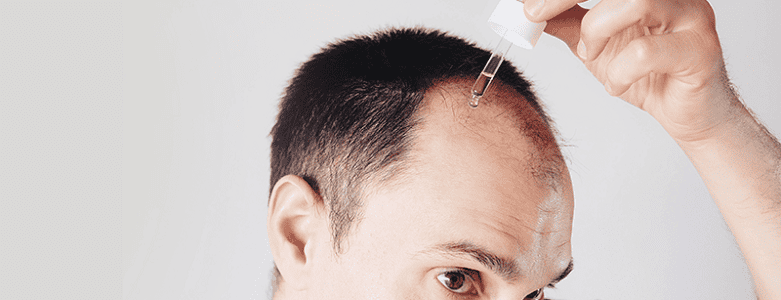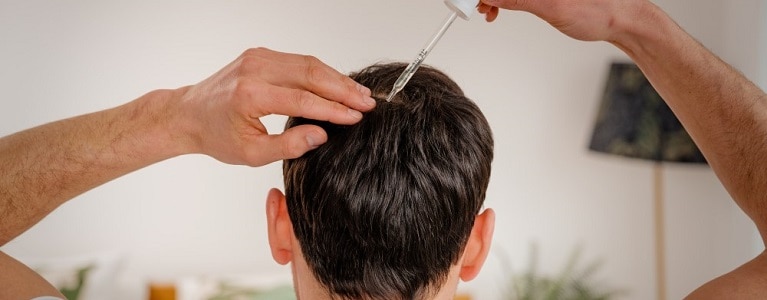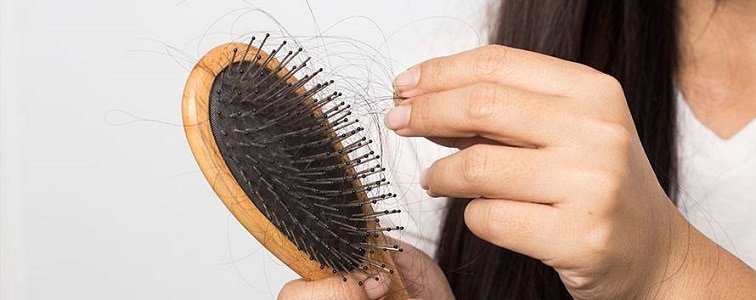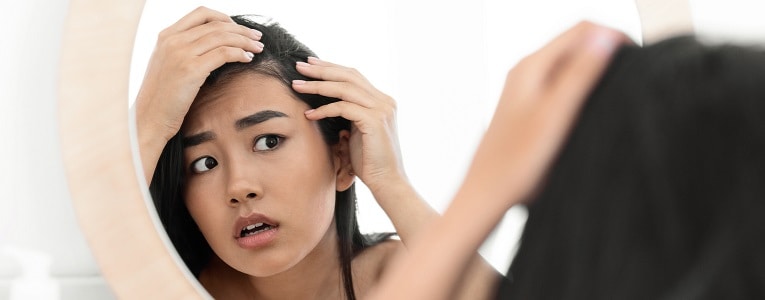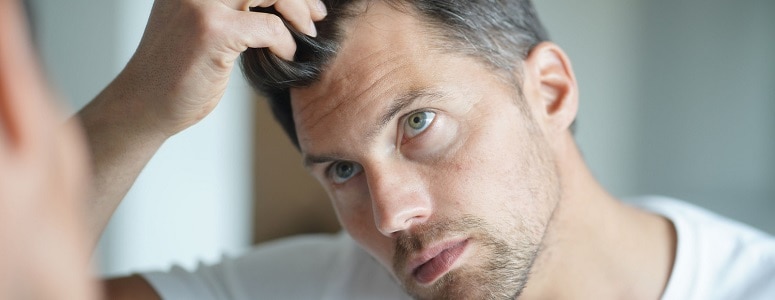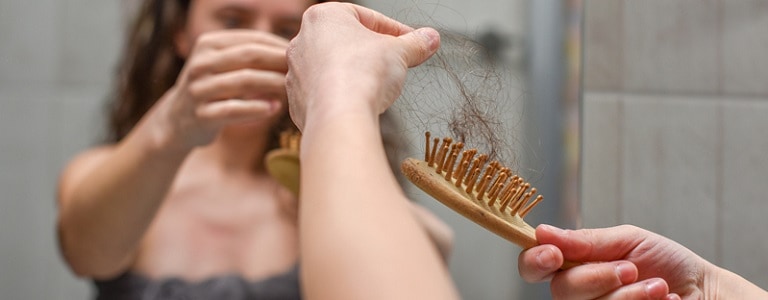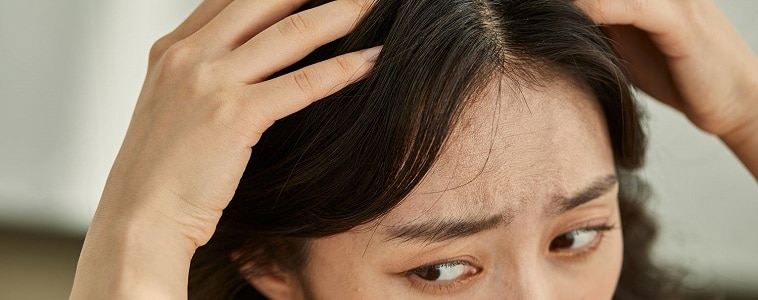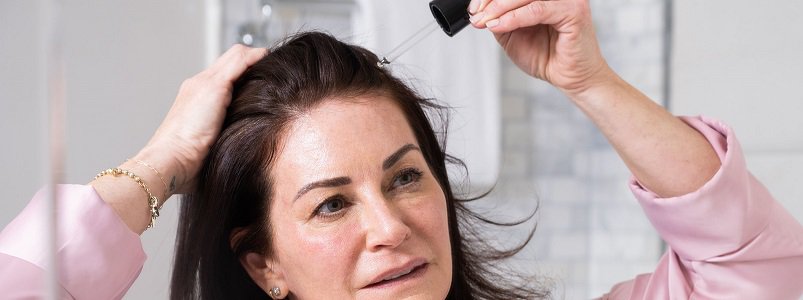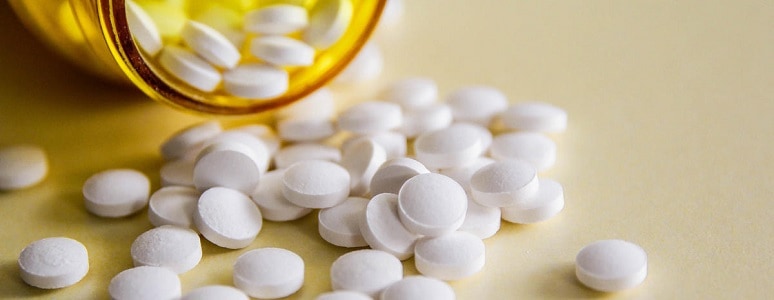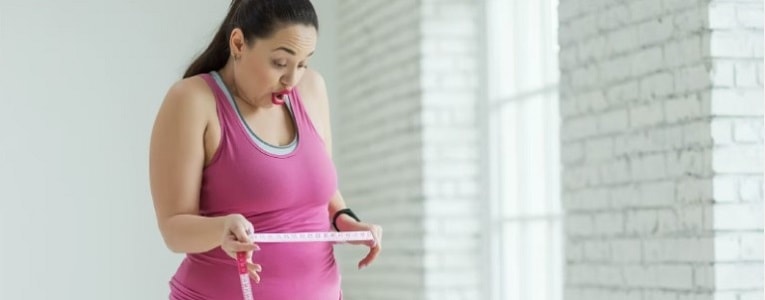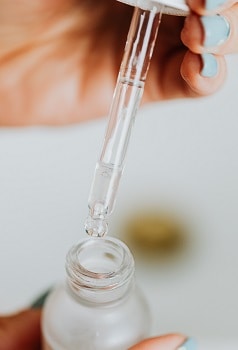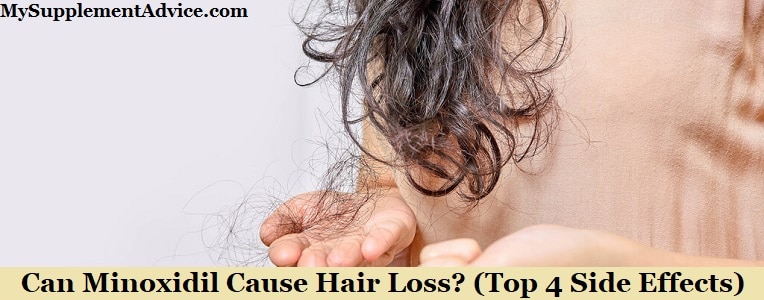
Minoxidil is one of the most popular treatments for hair loss.
However, one of the questions that need to be answered is – can minoxidil cause hair loss?
In other words, what side effects can this substance cause?
Let's discuss several important aspects in detail:
- how minoxidil works
- minoxidil and initial hair loss
- minoxidil and long-term hair loss
- the most common side effects it triggers
Keep reading and find out the answers to your questions.
Remember, knowledge is power!
Note. This article is based on my own research on side effects caused by minoxidil.
Minoxidil & Its Side Effects (In A Nutshell)
Minoxidil is one of the most popular treatments for hair loss.
However, have you ever wondered yourself – can minoxidil cause hair loss?
This article answers this question and talks about other common side effects of minoxidil.
In short, minoxidil can indeed cause initial hair loss:
- that's because it shortens the telogen phase
- in the first 2-8 weeks of using it, you might experience hair loss
- this happens with both versions of minoxidil (oral and topical)
What's more, you might experience hair loss after you stop the treatment.
That's because minoxidil is a treatment that works as long as you use it.
After that, the hair that grew with its help will fall out.
Yet, when it comes to increasing your hair growth, minoxidil can be indeed helpful.
What's more, it doesn't cause long-term hair loss.
Thus, if your hair continues to fall after 4 months, you might need to see a doctor.
What other side effects should you expect to experience?:
- dandruff
- irritation/itching
- the growth of unwanted hair (on the face or other parts of the body)
- weight gain
Those side effects are pretty annoying, right?
But minoxidil has its benefits too.
So, it's up to you to decide whether or not minoxidil is worth trying.
How Minoxidil Works
Did you know that minoxidil wasn't always a treatment for hair loss?
In fact, initially, minoxidil was designed to treat hypertension.
However, when it was discovered that it improves hair growth, it become a treatment for hair loss too.
So, let's find out how minoxidil works and what is its mechanism of action:
- it starts working within 4-8 weeks
- however, you won't see the results right away
- it speeds up the hair cycle
- promotes hair growth in several ways
What are the ways in which minoxidil stimulates hair growth?
Well, we will see that immediately.
However, before that, you need to know that minoxidil needs to be used on an ongoing basis.
Once you stop using it its effects start to wear off.
This is how minoxidil works and one of its drawbacks, I would say.
Now, let's talk about the ways in which minoxidil stimulates hair growth:
- shortens the telogen phase (or resting phase)
- makes the hair enter the anagen phase (growing stage)
- extends the follicles' growth stage
- increases blood flow around follicles
In short, this is the way in which minoxidil treats your hair loss.
Knowing its mechanism of action is important for future discussions about hair loss.
So, keep in mind that minoxidil accelerates the hair cycle and boosts hair growth.
Minoxidil & Initial Hair Loss
I already talked about the way in which minoxidil works.
In fact, because minoxidil speeds up the hair cycle, it can cause hair loss in the beginning. [1]
However, this is normal, so you shouldn't worry.
Here are a few things you need to know about the initial shedding period:
- appears when you first start using minoxidil
- occurs at the beginning of the treatment
- usually, it starts around 2 to 8 weeks after you start the treatment
- happens because minoxidil shortens and speeds up the resting phase
If it is the first time you are using minoxidil – you should expect your hair to fall faster.
How much hair will you lose in this initial hair-loss phase?
Well, this depends on the person. There isn't an exact answer to this question.
Then, when will this phase end?
In general, this period lasts up to 8 weeks. It's not that long, is it?
After that, you should notice some results. However, keep in mind the following:
- initial shedding shows that minoxidil is working
- after that, it takes up to 4 months to see the maximal effects of minoxidil
- in other words, in 4 months hair loss should decrease and new hair should grow
Hence, it is important to remember that the initial shedding period is normal.
In some cases, it is not even that noticeable.
Also, after this period ends, you will see the results!
Minoxidil & Long-Term Hair Loss
In which cases does hair loss become a concern (during the treatment with minoxidil)?
We talked about the initial phase in which shedding is normal.
However, if you're still shedding after 4 months, it means the treatment doesn't work.
However, the question that remains is – can minoxidil cause long-term hair loss?
To put it simply, the answer is no.
Then, what should you do if shedding doesn't stop after 4 months?
Well, here's my advice:
- stop the treatment
- see a doctor
- only your doctor can tell you what caused this shedding
In short, minoxidil causes hair loss at the beginning of the treatment.
After that, it should stop and you should see some results.
However, if you continue to lose hair, then the cause may not be minoxidil.
That's why I recommend you ask a doctor's advice.
Maybe minoxidil is not a suitable treatment for you.
Thus, pay attention to your hair when you use minoxidil!
Post-Minoxidil Hair Loss
What happens when you stop the treatment with minoxidil?
Well, as I told you already minoxidil is a lifelong treatment.
So, your hair will grow as long as you use minoxidil.
Once you stop the treatment, your hair will start falling out again.
This is normal because it is how minoxidil works (both the topical and the oral version).
In fact, there are some more details I need to tell you about minoxidil:
- it is an accessible and affordable treatment for hair loss
- however, it won't cure your problem
- it is a vasodilator, so it doesn't treat the cause
What to do in case you want to stop using minoxidil?
Well, expect your hair to fall again, of course.
Then, look for other treatments and remedies for hair loss.
Will you lose more hair after you stop the treatment? Not necessarily!
You will lose the hair you managed to regrow when you used minoxidil.
I know, at first, minoxidil seems to be the perfect solution to your problem.
However, as you can see, it has its drawbacks.
So, if you decide to use minoxidil make sure that you follow these instructions:
- don't use minoxidil discontinuously
- don't stop the treatment after you've seen the results
- maintain the result by continuing to use minoxidil
If you follow these instructions you will have satisfactory results.
Also, remember that minoxidil is a lifelong treatment.
So, before using it make sure that you know its drawbacks.
That also includes its side effects, about which I will talk in the next section.
Minoxidil & Dandruff
One of the most common side effects you might experience if you use minoxidil is dandruff.
This applies in the case of topical minoxidil, not the oral version.
Dandruff caused by minoxidil looks like flakes and can be annoying sometimes.
What else should you know about this side effect?:
- alcohol in minoxidil can dry out your scalp
- it can appear after a few months of using minoxidil
So, it is expected to experience dandruff while using minoxidil as it contains alcohol.
However, nobody wants a flaky scalp.
Then, what can you do to avoid and remove those flakes?
Well, here are some tips you might want to know:
- Try to wash your hair daily (before you use minoxidil)
- If you can't wash it daily, at least wash it on alternate days
- Try avoiding touching or scratching your flakes and scalp
- You might want to use a shampoo specially designed for a flaky scalp
I know, dandruff is not something you want to experience, but it can be treated.
So, I don't think I need to make a great deal out of this.
Especially because of the results minoxidil has.
However, this is not the only side effect minoxidil triggers.
Want to find out more? Continue reading!
Minoxidil & Irritation
Another common side effect minoxidil causes is scalp irritation.
As in the case of dandruff, I'm talking about topical minoxidil.
Why does scalp irritation appear?
Well, let me tell you a few details about this:
- scalp irritation is one of the symptoms of irritant contact dermatitis
- other symptoms are itching and scaling
- in other words, after using minoxidil you might have an allergic reaction
- this is irritant contact dermatitis
What causes such an allergic reaction?
Well, you might be allergic to propylene glycol or to minoxidil itself.
In other cases, itching might be the signal of irritation because of several ingredients from minoxidil.
What to do if your scalp feels itchy after using minoxidil?
First of all, observe to see if you experience other symptoms too.
A little bit of itching should not be a reason for you to worry. [2]
However, if you suspect you might suffer from irritant contact dermatitis, you should see a doctor.
For itching alone, those tips might be helpful:
- use a shampoo designed for your problem
- wash your hair as often as you can (even daily)
- maintain a good hygiene of the scalp and hair
- avoid scratching your scalp
- this will only lead to a worse scalp irritation
Those instructions might help you soothe your irritation.
Yet, keep in mind that if irritation and itching persist you may need to stop the treatment.
And, of course, in this case, is advisable to see a doctor.
Minoxidil & Body Hair
This is one of the most annoying side effects of minoxidil.
Who wants to have body hair in unwanted places?!
However, if you start the treatment with minoxidil you should know this might happen to you.
Also, the bad news is that minoxidil causes an increase in temporary hair growth in most people.
So, you may be among those who will experience this.
What's more, both versions of minoxidil (oral and topical) can trigger this side effect.
Can things get any worse? Well, there is some good news:
- topical minoxidil causes unwanted body hair in the places it comes in contact with
- body hair can be removed, right?
So, even if both versions of minoxidil can cause this side effect, there are some differences between them.
Topical minoxidil grows hair in the places it comes in contact with.
No matter if we talk about the scalp or other parts of the body.
In the case of oral minoxidil things are different:
- after a few weeks of using minoxidil, you might notice hair on the face [3]
- then, new hair might grow on the back, arms, and legs
So what can you do in those cases?
Well, in the case of oral minoxidil, the only thing you can do is remove the unwanted hair.
In the case of topical minoxidil, you can prevent the growth of unwanted hair.
Just make sure that you follow these instructions:
- Apply the solution/foam only on the scalp.
- Make sure that minoxidil does not get to other parts of your body or clothes.
- Keep the solution especially away from the face (templates and forehead).
- Wash your hands thoroughly after you applied the solution/foam.
Those tips probably will help you prevent the growth of unwanted hair.
However, if you still experience this side effect, you can easily remove the hair.
So, this side effect should not stop you from trying minoxidil, if that's what you want.
Yet, if the unwanted hair worries you, you can first use topical minoxidil.
What do you think? Is minoxidil still worth trying?
Minoxidil & Weight Gain
Who isn't concerned about his/her weight?
That's why I want to mention one of the side effects of oral minoxidil.
I'm talking about weight gain.
This can be especially annoying if you kept a diet recently and managed to lose some weight.
So, which of the two versions of minoxidil can trigger this side effect? Both of them?
Actually, no. Only oral minoxidil can have this side effect.
That's because oral minoxidil is an internal treatment.
However, things are not as bad as they seem:
- a weight gain of 2 to 3 pounds in an adult is normal
- yet, you should be able to lose this weight during the treatment
I told you that there is some good news too.
As you can see you won't gain much weight and you will probably lose it after a while.
Still, why does oral minoxidil cause this side effect?
Well, here are the reasons:
- water and sodium retention can occur while you take oral minoxidil
- this may lead to side effects like weight gain or edema
Weight gain is a pretty common side effect of minoxidil pills.
So, if you decide to try oral minoxidil take into consideration these aspects.
After all, the decision belongs to you.
Final Conclusion
To cut a long story short, minoxidil can be an effective treatment for hair loss.
Yet, the question that remains is can minoxidil cause hair loss?
Well, both the oral and the topical versions have similar mechanisms of action.
Because of the way they work, in the beginning, they can cause hair loss:
- initial hair loss is normal
- it happens because minoxidil shortens the telogen or resting phase
- it starts after 2 to 8 weeks of using minoxidil and lasts up to 8 weeks
What you also need to know is that minoxidil doesn't cause long-term hair loss.
Yet, you will experience hair loss if you stop the treatment as minoxidil is an ongoing medicine.
What other side effects can minoxidil cause? Well, here are some of them:
- dandruff
- irritation/itching
- growth of unwanted hair
- weight gain
So, before you start your minoxidil treatment make sure you know all those things.
That's because minoxidil has both benefits and drawbacks.
Thus, what do you think? Can you deal with those side effects?
References:
1 – https://pubmed.ncbi.nlm.nih.gov/-22409453/

